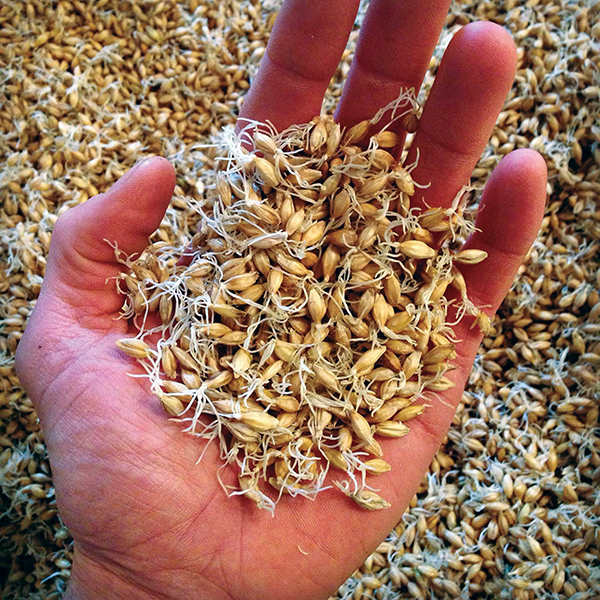Great Grains
by Alex Jones
Any beer lover in Philly can tell you that the region is in the midst of a craft beer boom. Between 2013 and 2015, the number of licensed breweries in the state nearly doubled to meet demand, from 114 to 224, according to state Liquor Control Board figures. Local beers dominate draft lists at bars and brewpubs across Southeast Pennsylvania.
The only drawback? Usually, the only locally sourced ingredient in these “local” beers is the water.
But Deer Creek Malthouse in Glen Mills—the first malthouse in Pennsylvania since Prohibition—is working to change that.
Since opening in 2014, “Our focus has really been on trying to figure out how to make really high-quality malt using locally sourced grain, and to try to understand the market and build a brand,” said Mark Brault, Deer Creek’s founder. “We’re happy with what’s in the bag right now and the response we’ve gotten from the market.”
Brault, who was a biologist for Merck before embarking on the quest to bring back Pennsylvania malt, works alongside co-owners Josh Oliver, a chemist, and farmer Scott Welsh to identify types of barley and other malting grains that grow well in Pennsylvania’s climate, contract with farmers to grow an optimal product for malting, and process grain into malt. Most malt for conventional and craft brewing comes from grain-growing regions like the upper Midwest and Central Europe.
Beer typically has four main ingredients: malt, hops, yeast and water. Most of the flavor—and the alcohol content—comes from fermenting malt. Malt is grain (typically barley) that’s been carefully steeped, germinated and dried to develop enzymes that will convert its starches into sugars—which, once yeast is pitched into a batch of beer, can be converted into alcohol.
The traditional method they use, floor malting, involves spreading the grain in an even layer on the floor of a special room in the malthouse, then raking and turning it by hand as it germinates. It’s labor-intensive, but advocates say that processing the grain this way creates more complex flavors than when this step is done by machine. Next, the grain is heated in a huge kiln, monitored for temperature and humidity for a full day and night—which necessitates sleeping at the malthouse—and is then cleaned and bagged for sale.
Tröegs Brewing Company in Hershey, Free Will Brewing Company in Perkasie and New Liberty Distillery in Kensington are some of Brault’s devoted wholesale customers. Keystone Homebrew sells a wide variety of Deer Creek’s malt in home-scale packages through its website and at its stores in Montgomeryville and Bethlehem.
“It’s really cool to be able to say this was grown right down the road, within three hours of here,” said John Trogner, founder of Tröegs. “It gives [the beer] a sense of terroir, a sense of place—it’s a little niche that you can’t get anywhere else.”
Due to limited supply, Trogner has only been able to highlight Deer Creek’s unique malts in small-batch, special-edition beers. But as the malt becomes more available and accessible, he hopes to brew larger batches, which could be enjoyed by beer drinkers throughout the brewery’s 11-state distribution footprint.
While breweries are Deer Creek’s primary customers, there’s market potential for local malt in the region’s bakeries, farm-to-table restaurant kitchens and food artisans. Deer Creek’s malt has made its way into the hands of such food artisans as Ryan and Eric Berley at Shane Confectionery and cheesemaker Sue Miller of Birchrun Hills Farm, who’s developing her take on an Italian cheese that’s aged with a coating of malted barley applied to its rind.
The much-lauded High Street on Market uses Deer Creek malt all over its menu—in its sourdough breads as well as in savory dishes and desserts.
“Deer Creek is a perfect encapsulation of what we love and value in the High Street bread, pastry and savory programs,” said Sam Kincaid, who oversees bread and pastry at High Street on Market. “[We prioritize] extracting natural sweetness and complexity from seemingly simple or familiar ingredients, and giving expression to our local agroecosystem and benefiting as much as we can those producing quality ingredients using methods we respect.”
At High Street on Market, local malt is used to boost dough development and depth of flavor. In the kitchen, it might be used to intensify flavor in a dish like a smoked malt flour pasta served with beef heart ragout or to evoke nostalgic flavors by steeping ice cream with Dutch malt.
Now that the Deer Creek Malthouse team has assembled a group of producers to grow barley that’s perfect for malting—and put high-quality malt into the hands of customers—they’re focusing on overcoming the next big hurdle: how to produce more malt with those same standards, reach more markets and start paying themselves—spending fewer nights in the barn tending batches would be nice, too.
“We need to add capacity to keep up with demand,” Brault says. “We also need to see how we can lower our costs to get to a scale [so] that there’s enough malt at the right price for our customers to be able to use more of it.”



